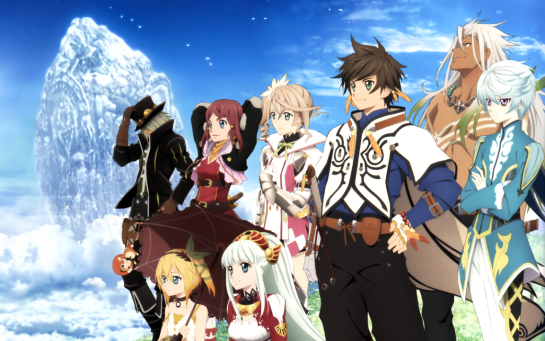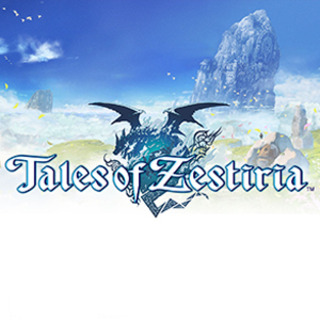
Not so easy to come after super great RPGs like Tales of Xillia 1&2. Even more difficult to come after having made the headlines of scandal sheets. It will be therefore necessary to be through-fully objective to appreciate Tales of Zestiria in its true self.
Zestiria’s storyline is not that complex. With this episode, the series is back to an old-fashioned narrative like Final Fantasy and Dragon Quest back in the day. Fire/Water/Earth/Wind temples are also back to the party, a truly sensitive tribute to the RPGs of the 90’s/2000’s. The world of Zestiria is divided, as always, between to separate location and tribes. The human world is dying, plagued by illness, conspiration and war. The Tenzoku, eternal spirits, have long given up on humans and live hidden on the top of the world. Sorey, only human to live among the Tenzoku, will eventually go back to his native land following his random encounter with princess Alicia. He will become the “Sheperd”, legendary warrior who appear once a generation to drive off evil and bring peace.
Despite relying on a worn-out opposition between Good and Evil, Tales of Zestiria achieves a great narrative thanks to a genius direction, contrary to competing RPGs that sacrifice that aspect to artificially expand their surface and length. Tales of Zestiria also renews its interest by a flurry of mini-stories often dark and pretty hard because purposely avoiding happy end. The game is in this way quite mature and shows the dark side of human society without unnecessary optimism. On the other hand, this latest installment entertains as much as ever by its comical cut-scenes, Edna probably being the mood maker of the year. This gothic lolita Tenzoku keeps teasing her comrades in an always hilarious fashion.
Nevertheless, Tales of Zestiria kinda lacks clarity in its story in general : too conceptual, it might lose the player in its late stages. But this is not the biggest issue because early in the game, the story ousts an important character to be replaced by another. This is a big blunder of porducer Hideo Baba, because the transition is extremely awkward. You feel like a second game is put onto the first one. A malaise hardly fixed by the (free) DLC chapter which is everything but fascinating story-wise.
In terms of gameplay, it’s once again a success. Your team is composed of Sorey, Rose and 4 Tenzoku. You can play each of them alone in a system close to Tales of Graces F : combos of 3 or 4 successive skills at the end of which you can add a magic spell. The big thing is that the longer the combo, the quicker you can launch the magic. This drives the player into taking risks in shifting all the time between magic and physical attacks. It’s actually the same system as Tales of Graces F, but 20 times faster! More than ever, battles relies on dexterity and dodging. All the pleasure involves seeking the small opening in the massive enemy attacks. 2 tenths of second before, it’s too early, 2 tenths of second after, you’re dead. It’s even more intense than before, because the player is required to be 120% focused to cope with the high speed and the short decision time. Big drawback though, the camera goes totally wild indoors and very often makes you blind. It doesn’t ruin the game in a whole, but it’s definitely frustrating.
Sorey and Rose can merge with one of the Tenzoku and take an angel-like form gifted with the powers of the Tenzoku‘s element. Combining forces with Laila provides a giant fire blade while Mikurio gives its partner a water bow, etc. This form, called Kamui, is a lot more powerful than an individual character and can be used by consuming BG (blast gauge points, which gradually regenerate). On the other hand, it reduces the number of characters on the field and thus your possibilities of support. Furthermore, the defeat of a Kamui leaves both characters KO, so you have to be extra-careful. Better designed than others, Tales of Zestiria features a truly efficient healing system aimed at ensuring a rapid flow of battle. The Kamuihas a personal healing spell (but it costs one BG) but more importantly, Sorey and Rose can be resurrected as long as there’s at least one Tenzokuwith BG. Eternal spirits, the Tenzoku revive themselves naturally after sometimes in the back. You can therefore stay in battle in seamless fashion if you’re nimble enough to avoid the enemy’s formidable offensive, life bottles and other healing items having nearly become… obsolete!
A Kamui must use its BG wisely. Adding the above mentioned healing spell, it has two offensive capabilities after the base combo. The first one is an additional blow far more powerful than average (1BG), the second one being no other than the famous 秘奥義, supreme attack that can do tens of thousands HP damage! Each individual character has its own, but a a far lesser scale. The Kamui are extremely enjoyable : any of its attacks is impressive to play and to watch. Let’s also stress that Tales of Zestiria benefits from an amazing sound environment. In a Kamui for example, both characters speak at theme same time and it gives a tremendous to the action. Japanese budding is no less good and the soundtrack is beautiful. Town music is very entertaining and dungeon themes are even better. The battle theme Zavida the Exile is one of the best I’ve heard this year.
I keep seeing the word “open-world” associated to Tales of Zestiria… No, the series does NOT jump in the open world trend with this episode. We have to stop thinking there’s an open world every time we see a hectare of grass! It’s no more open world than Xillia, Vesperia, Symphonia or any other for that matters. The progression is pretty classic with areas unlocked one after another. It is even fairly linear at the beginning, nearly upsetting because the mini-map showing every little objective can’t be deactivated. Fortunately, later the game stops pointing the way and gives only hints to complete the sidequests, which are not side content since you have to clear all of them. Dungeons are quite large and complex : two of them nearly toasted my brain. The inventory system is deep and hooking : every weapon, armor or accessory have passive skills attached to them, and combination of skills provide more skills. You can also merge equipments at the smith’s, it’s endless if you go through it with precision. Another good point for Zestiria’s gameplay which has both variety and quality.
Only the PS3 version is available in Japan and I wonder why : this old-gen version lacks polish and textures aren’t good. You can even see pixelation on the characters if you’re close to the screen! Xillia’s 3D engine is clearly derelict at this point. Even though the design of some towns are plains are cool, it’s rare to impressed by Zestiria’s graphics. The game actually focuses on the main characters, whose animation is flawless and lively, which guarantees attractive battle action and nice cut-scenes. I’ve had a hard time playing without my PS4share, all the more difficult that the screencap option via the XMB of the PS3 has vanished without any reason.
Tales of Zestiria’s case show that people and observers need some hindsight before jumping to conclusions. Because beyond the dramatic headlines and the senseless contempt, you find rich JRPG, well-designed and bearer of amazing battle system.

